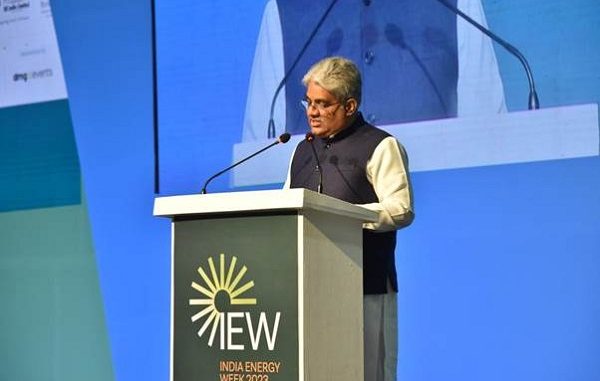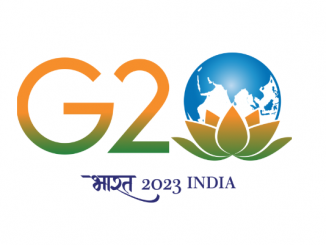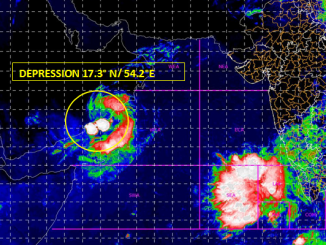
Feb 09: Union Minister of Environment, Forest and Climate Change, Shri Bhupender Yadav today addressed the Ministerial Session on ‘Adapting to an Uncertain Future: Reshaping of Global Partnerships’ at India Energy Week in Bengaluru. Her Excellency Magna Mudyiwa, Deputy Minister of Energy and Power Development, Zimbabwe was also present.
Speaking on this occasion Shri Bhupender Yadav said that under the able leadership of Prime Minister Shri Narendra Modi, India has emerged as one of the global forerunners with the ability to show concrete and collective resolve to ensure harmony and energy security in the world at a time when global energy supply chains are in a troublesome state, a crisis of essentials is present all over the world. He also said that to reshape the global partnership, India has adopted a “whole-of-society” approach with governments engaging at national, sub-national and local governments levels, including the private sector, civil society organizations, local communities, and people in vulnerable situations.
Shri Yadav said that today, India is one of the fastest-growing emerging market economies with a young population and burgeoning innovation and business ecosystem. With Nominal GDP for 2023/24, estimated to grow 10.5% year-on-year to 301.75 trillion rupees (USD 3.69 trillion) in 2023/24, India strives to become a USD 5 trillion economy by 2025.
Noting that India is at the centre of the energy transition, combining economic and energy demand growth with rapid decarbonisation, Shri Yadav said that India stands committed to reducing the emissions intensity of our GDP by 45% by 2030 and subsequently reach to net zero by 2070. In this context, he also said that India’s commitment to a sustainable and carbon-neutral future is being guided by its enhanced National Determined Contribution (NDC) and Long-Term Low Carbon Development Strategy which call for clean and efficient energy systems, disaster-resilient infrastructure, and planned eco-restoration. India’s net-zero goal entails a five-decade-long journey and India’s strategy must therefore be evolutionary and flexible, accommodating new developments in technology, the global economy and international cooperation, he said.
Shri Yadav also said that India’s long-term low-carbon development strategy to reach net-zero by 2070 notes, inter-alia, that alongside the imperative of development, and the need to ensure the country’s energy security, based both on the expansion of non-fossil fuel sources for power generation and rational utilization of fossil fuel resources. India’s long-term low-carbon development strategy, therefore, rests on seven key transitions to low-carbon development pathways. In the context of energy security, the Strategy calls for low-carbon development of electricity systems consistent with development; development of an integrated, efficient and inclusive transport system; promotion of energy and material efficiency in buildings, and sustainable urbanization; and economy-wide decoupling of growth from emissions and development of an efficient, innovative low-emission industrial system.
The Union Environment Minister highlighted that in the Union Budget 2023-24 greening the economy is one of the top seven priorities (Saptarishi). He said that India has launched, and is nurturing many programs for green fuel, green energy, green mobility, green buildings, and green equipment, and policies for efficient use of energy across various economic sectors. Ethanol blending with petrol, the National Green Hydrogen mission, the promotion of electric vehicles and the tremendous push on the renewable energy front are some of the significant initiatives that India is pursuing towards a clean and green energy future. These initiatives are playing important role in India’s Energy transitions and to provide for large-scale green job opportunities, he said.
Highlighting the primary characteristics of Union Budget 2023-24, Shri Yadav said that, it reflects the Government’s nonstop commitment towards India’s Energy Transition. Some of the important initiatives of the Union Budget are:
- Energy Transition: This Budget provides ` 35,000 crores for priority capital investments towards energy transition and net zero objectives, and energy security by the Ministry of Petroleum & Natural Gas.
- Green Hydrogen Mission with an outlay of ` 19,700 crores, is to facilitate energy transition and reduce dependence on fossil fuel imports
- Energy Storage Projects: To steer the economy on the sustainable development path, Battery Energy Storage Systems with a capacity of 4,000 MWH will be supported with Viability Gap Funding.
- Renewable Energy Evacuation: The Inter-state transmission system for evacuation and grid integration of 13 GW renewable energy from Ladakh is being constructed with an investment of ` 20,700 crores including central support of ` 8,300 crores.
- GOBARdhan scheme: 500 new ‘waste to wealth’ plants under GOBARdhan (Galvanizing Organic Bio-Agro Resources Dhan) scheme will be established for promoting a circular economy.
The Union Environment Minister said that these initiatives must also be viewed as opportunities to enhance India’s collaboration with various stakeholders to reshape global partnerships in the energy sector and to better adapt to an uncertain future.
In his concluding remarks, Shri Yadav quoted Prime Minister Shri Narendra Modi, who in his address at the G-20 Summit in Bali, Session I: Food and Energy Security, said,
“India’s energy security is also important for global growth, as it is the world’s fastest-growing economy. We must not promote any restrictions on the supply of energy and stability in the energy market should be ensured. India is committed to clean energy and the environment. By 2030, half of our electricity will be generated from renewable sources. Time-bound and affordable finance and sustainable supply of technology to developing countries is essential for the inclusive energy transition.”
Disclaimer: We donot claim that the images used as part of the news published are always owned by us. From time to time, we use images sourced as part of news or any related images or representations. Kindly take a look at our image usage policy on how we select the image that are used as part of the news.


